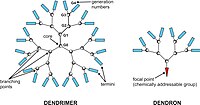
Photo from wikipedia
Recently, due to the possibility of thinning down to the atomic thickness to achieve exotic properties, layered materials have attracted extensive research attention. In particular, PbI2 , a kind of… Click to show full abstract
Recently, due to the possibility of thinning down to the atomic thickness to achieve exotic properties, layered materials have attracted extensive research attention. In particular, PbI2 , a kind of layered material, and its perovskite derivatives, CH3 NH3 PbI3 (i.e., MAPbI3 ), have demonstrated impressive photoresponsivities for efficient photodetection. Herein, the synthesis of large-scale, high-density, and freestanding PbI2 nanosheets is demonstrated by manipulating the microenvironment during physical vapor deposition. In contrast to conventional two-dimensional (2D) growth along the substrate surface, the essence here is the effective nucleation of microplanes with different angles relative to the in-plane direction of underlying rough-surfaced substrates. When configured into photodetectors, the fabricated device exhibits a photoresponsivity of 410 mA W-1 , a detectivity of 3.1 × 1011 Jones, and a fast response with the rise and decay time constants of 86 and 150 ms, respectively, under a wavelength of 405 nm. These PbI2 nanosheets can also be completely converted into MAPbI3 materials via chemical vapor deposition with an improved photoresponsivity up to 40 A W-1 . All these performance parameters are comparable to those of state-of-the-art layered-material-based photodetectors, revealing the technological potency of these freestanding nanosheets for next-generation high-performance optoelectronics.
Journal Title: Advanced materials
Year Published: 2017
Link to full text (if available)
Share on Social Media: Sign Up to like & get
recommendations!